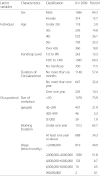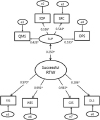1. Industrial Accident Compensation Insurance Act. 2007. (Article 1).
2. Infante-Rivard C, Lortie M. Prognostic factors for return to work after a first compensated episode of back pain. Occup Environ Med. 1996; 53(7):488–94. DOI:
10.1136/oem.53.7.488. PMID:
8704875.
3. Jeong W, Park C, Koo J, Roh YM. Predictors of return to work in occupational injured workers. Kor J Occup Environ Med. 2003; 15(2):119–31.
4. Park SK, Ahn CM. Predictors of job retention among worker's compensation clients in South Korea. Soc Welf Policy. 2006; 26:177–94.
5. Kang H, Im H, Kim Y, Ju Y, Lee H, Kim J, et al. Predictors of return to work and Job retention after work-related injury or illness. Kor J Occup Environ Med. 2006; 18(3):221–31.
6. Park SK. Successful return to work and related factors among Job injured workers in Korea. J Rehabil Res. 2012; 16(3):293–318.
7. Lee J. Evaluation of the affective factors for return-to-work of injured worker. 2009. Seoul: Graduate School of Health Science and Management, Yonsei University.
8. Hamer H, Gandhi R, Wong S, Mahomed NN. Predicting return to work following treatment of chronic pain disorder. Occup Med. 2013; 63(4):253–9. DOI:
10.1093/occmed/kqt019.
9. Park SK. A study on factors affecting reemployment of the disabled workers owing to industrial injury in Korea. Kor J Soc Welf. 1999; 37:171–93.
10. Yang JS, Oh SB, Lim SS. Determinant factor analysis for return to work types of occupationally injured workers. Kor Soc Secur Stud. 2012; 28(3):153–77.
11. Yee SY. An analysis on the employment duration of the workers injured in industrial accidents. Kor J Labour Econ. 2004; 27(3):25–52.
12. Baldwin ML, Butler RJ. Upper extremity disorders in the workplace: costs and outcomes beyond the first return to work. J Occup Rehabil. 2006; 16(3):303–23. DOI:
10.1007/s10926-006-9043-2. PMID:
16933145.
13. Pransky G, Gatchel R, Linton SJ, Loisel P. Improving return to work research. J Occup Rehabil. 2005; 15(4):453–7. DOI:
10.1007/s10926-005-8027-y. PMID:
16254748.
14. Park EJ. The employment duration at first return-to-work of injured workers. Kor J Soc Welf Stud. 2014; 45(2):123–46. DOI:
10.16999/kasws.2014.45.2.123.
15. The 1st basic report for panel study of Worker's compensation insurance. 2014.
16. Kim J. The effects of elderly Patients' dental satisfaction on revisit intention with the application of SEM (Structural Equation Model). 2013. South Korea: Inha university.
17. Sherer M, Maddux JE, Mercandante B, Prentice-Dunn S, Jacobs B, Rogers RW. The self-efficacy scale: Construction and validation. Psychol Rep. 1982; 51:663–71. DOI:
10.2466/pr0.1982.51.2.663.
18. Rosenberg M. Society and the adolescent self-image. 1965. NJ.: Prinsceton.
19. Jon B. Self-esteem: a test of its measurability. Graduate School Yonsei University. 1974; 11(1):107–30.
20. Hong HY. The relationships of perfectionism, self-efficacy and depression. Graduate School Ewha Womans University. 1995; 8:53–9.
21. Chen F, Curran PJ, Bollen KA, Kirby J, Paxton P. An empirical evaluation of the Use of fixed cutoff points in RMSEA test statistic in structural equation models. Sociol Methods Res. 2008; 36(4):462–94. DOI:
10.1177/0049124108314720. PMID:
19756246.
22. Lee HJ, Kim KM. The effects of perceived career barrier of women whose career were interrupted on career preparation behavior. Kor J Counseling. 2010; 11(2):623–40. DOI:
10.15703/kjc.11.2.201006.623.
23. Park SK. Factors associated with depression among injured workers with disabilities returning to work in South Korea: Comparison of return to pre-injury job with work at a new firm. Kor J Soc Welf Res. 2013; 37:149–74.
24. Lee S. The return-to-work system of the industrially injured workers in Korea. J Vocat Rehabil. 2011; 20(3):1–34.
25. Choi M, Kim H, Lee J, Lee H, Byun J, Won J. Workers' experiences with compensated sick leave due to musculoskeletal disorder: a qualitative study. Ann Occup Environ Med. 2014; 26(1):33. DOI:
10.1186/s40557-014-0033-0. PMID:
25852943.
26. Lee DY. An experimental study on the vocational rehabilitation service delivery system for persons with industrial injuries. J Special Educ. 2006; 7(4):283–305.
27. Jeon BY, Kwon SM, Cho BH, Lee TJ. Factors associated with employment and life satisfaction of occupationally injured people. Kor Soc Secur Stud. 2010; 26(2):199–222.










 PDF
PDF Citation
Citation Print
Print


 XML Download
XML Download